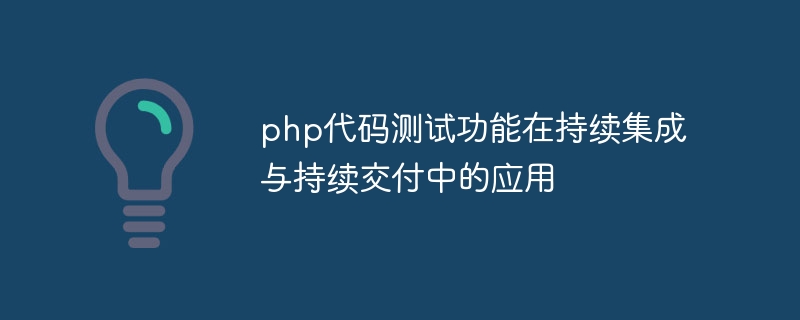Home >Backend Development >PHP Tutorial >Application of PHP code testing function in continuous integration and continuous delivery
Application of PHP code testing function in continuous integration and continuous delivery
- 王林Original
- 2023-08-13 19:53:131387browse

Application of PHP code testing function in continuous integration and continuous delivery
With the continuous development of Internet technology, the software development process is also constantly improving. Continuous Integration and Continuous Delivery are two concepts that are widely used in software development. Among them, the code testing function plays a crucial role in both processes. This article will take PHP code as an example to introduce how to apply code testing functions in continuous integration and continuous delivery, and give relevant code examples.
1. Code testing function in continuous integration
Continuous integration means that developers frequently merge new code into the trunk (main code base) while developing code, and Perform automated builds, tests, and deployments. Code testing is the core link in continuous integration. It can ensure whether the new code can run normally and identify and fix potential problems in a timely manner.
In PHP development, we usually use PHPUnit as a tool for code testing. The following is a simple example that demonstrates how to use PHPUnit to test a PHP function:
// 源文件:example.php
/**
* 计算两个整数的和
* @param int $a 整数1
* @param int $b 整数2
* @return int 计算结果
*/
function add($a, $b) {
return $a + $b;
}// 测试文件:exampleTest.php
require_once 'example.php';
use PHPUnitFrameworkTestCase;
class ExampleTest extends TestCase {
public function testAdd() {
$this->assertEquals(3, add(1, 2));
}
}In this example, we define a function add() to calculate the sum of two integers. Then, we wrote a corresponding test class ExampleTest, in which the testAdd() method tested the add() function and used assertEquals() assertion to verify the results.
Running PHPUnit through the command line, we can perform a test on this function:
$ ./vendor/bin/phpunit exampleTest.php
If the test passes, PHPUnit will output a green message indicating that the test passed; if the test fails, PHPUnit will output A red message indicating the reason for the failure. Continuous integration systems usually execute this command automatically and feedback test results to developers.
2. Code testing function in continuous delivery
Continuous delivery refers to delivering software changes to users as quickly and frequently as possible to facilitate timely collection of feedback and adjustments. In continuous delivery, code testing capabilities are used to ensure the quality of software delivered each time and to avoid potential problems that affect the user experience.
The following is an example of code testing in continuous delivery. Assume that we use Git as the version control system and Jenkins as the tool for continuous integration and continuous delivery:
- Create in Git A new branch (for example: feature-xxx), code development is carried out on this branch.
- During the code development process, we can use tools such as PHPUnit for code testing. We can run code tests to verify the correctness of the code before each submission. The following is an example of a Jenkins Pipeline script:
pipeline {
agent any
stages {
stage('Checkout') {
steps {
git branch: 'feature-xxx', url: 'git@github.com:your-repository.git'
}
}
stage('Build and Test') {
steps {
sh 'composer install'
sh './vendor/bin/phpunit'
}
}
stage('Deploy') {
steps {
// 进行部署操作
}
}
}
}In this example, we define three stages: Checkout for checking out code, Build and Test is used for building and testing, Deploy is used for deployment. In the Build and Test stage, we ran composer install to install dependencies, and then executed the ./vendor/bin/phpunit command to run code tests.
- After the code passes the test, we can merge the code into the trunk. Jenkins can automatically deploy code to the production environment to complete the delivery of software changes.
Through the above steps, we can use the code testing function in the continuous delivery process to ensure the quality of the software delivered each time.
Conclusion
This article takes PHP code as an example to introduce the application of code testing function in continuous integration and continuous delivery. By using testing tools such as PHPUnit, we can frequently run code tests during the development process, discover and fix potential problems in a timely manner, and ensure software quality. In continuous delivery, the code testing function can ensure the quality of software delivered every time and avoid potential problems that affect the user experience. Not only that, continuous integration and continuous delivery can further improve the efficiency and quality of the software development process and promote team collaboration and innovation.
The above is the detailed content of Application of PHP code testing function in continuous integration and continuous delivery. For more information, please follow other related articles on the PHP Chinese website!
Related articles
See more- Getting Started with PHP: Continuous Integration
- Introduction to continuous integration tools in Java language
- PHP development: continuous integration and continuous deployment using CI/CD and Jenkins
- How to use Go language for continuous integration and continuous deployment
- Analysis of black box testing and white box testing technology of PHP code testing function

